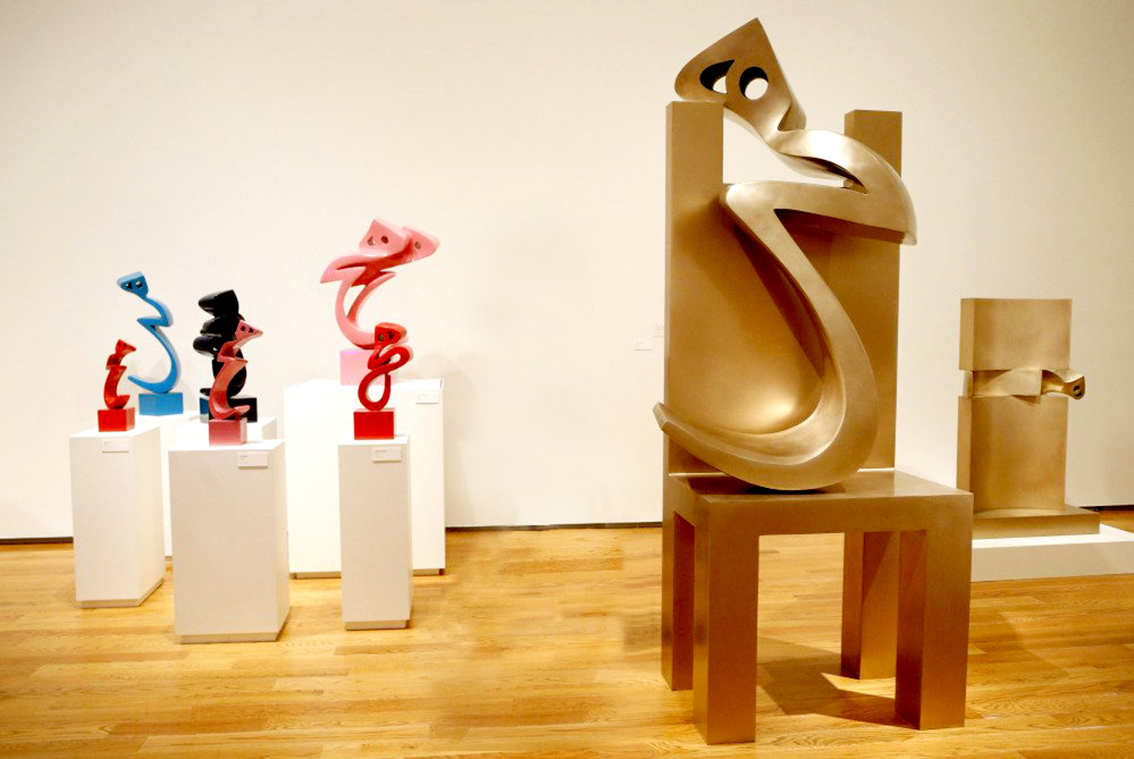A series of major exhibitions in the Northeast devoted to art from Iran kicked off this month in Massachusetts with Parviz Tanavoli, a retrospective of one of Iran’s most admired modernists, at the Davis Museum at Wellesley College.
That the Davis is one of several US museums this year “daring to present a vision of Iran does it great credit.” Relations between the two countries “are as combustible as ever; the logistics of loans, travel, and funding are consequently daunting,” says an article by Sebastian Smee in bostonglobe.com.
But the Davis is not alone. The Tanavoli show coincides with ‘Bazm and Razm’, an exhibition at the Metropolitan Museum of Art in New York devoted to themes of feasting (bazm) and fighting (razm) in Persian art since the 15th century. Next month, the Guggenheim Museum in New York will present a survey of mirror works and drawings by the celebrated Iranian modernist Monir Shahroudy-Farmanfarmaian, now in her 90s. And in May, the Hirshhorn Museum and Sculpture Garden in Washington, D.C., will mount ‘Shirin Neshat: Facing History’, a look at the career of the acclaimed photographer and filmmaker — perhaps the best known of Iran’s recent crop of contemporary artists.
Retrospective
The Tanavoli retrospective has been organized by Davis’s director Lisa Fischman, and Brown University art historian Shiva Balaghi, and sponsored by the London-based philanthropists Maryam and Edward Eisler and Goldman Sachs. It is a major event — a great introduction both to a very fine artist and to some of the complexities of Iranian art in the modern era.
The show is bustling with sculptures in shiny, patinated, or brightly painted bronze or stainless steel, as well as paintings, works on paper, painted ceramics, metalwork, jewelry, and neon.
Steeped in Persian culture, Tanavoli is a poetic, philosophical artist. Some of his work has a drowsy, overly symmetrical character — the symptom of an artist perhaps too enamored of symbols and universals, not enough interested in specifics.
But at his best, he combines a strain of melancholy that feels peculiarly Iranian with the stark declarative flourish, the insouciant style, and the energy of Pop Art.
American Pop Art actually was a crucial early influence on Tanavoli, who divides his time between Vancouver, British Columbia, and Tehran. Born in 1937, he studied art in Tehran and then Carrara, Italy. Back in Iran in 1958, he mounted a show remembered as the first modern sculpture exhibition.
He returned to Italy to further his studies in Milan, and then established a studio on today Vali-Asr Avenue, in Tehran.
Tanavoli began collecting locks, posters, carpets, and talismans, incorporating many of his finds in his work: both literally, in assemblages, and as graphic signs.
Shortly after meeting the US philanthropist and collector Abby Weed Grey in 1961, Tanavoli saw more of American modernism.
In 1965, Tanavoli hit on the motif for which he is best known: a calligraphic figure known as ‘heech’, the Persian word for ‘nothingness’. He has since made hundreds of ‘heech’ works, most but by no means all of them sculpted. They are huge and tiny, in bronze and in neon, on boxes or behind bars. They are endlessly supple — both materially and philosophically. Like dancing figures, they twist and writhe, leap and recline, and refuse to be pinned down.
The Davis show boasts an impressive congregation of them, centering on an 11-foot stainless steel version. Smaller ones are painted pink, blue, red, and black. They provide a welcome island of color in a show that is otherwise overwhelmingly bronze-colored.
Why ‘Heech’?
Tanavoli has explained that, at the time he hit upon ‘heech’, he was caught between wanting to ward off a sense of nothingness and wanting to succumb to it.
Given this resistance, it’s obviously ironic that Tanavoli’s renown today rests in large part on ‘heech’, especially since calligraphy continues to feature (mostly as a decorative element with exotic overtones) in the work of Iranian artists most sought after in the West today.
But Tanavoli’s ‘heech’ can embrace these and even bigger ironies. Its meaning derives from strains of Sufism, which regard “nothingness” in mystical terms, linked to the dissolution of ego, the unity of all things, and a paradoxical fullness of life.
Many works of famous artists’, including Robert Rauschenberg’s monochrome canvases and Andy Warhol’s endlessly repeated soup cans were, Tanavoli has said, expressions of ‘heech’.
Drawing on figures and stories in Iran’s great national epic, the ‘Shahnama’ (or Book of Kings), and on a panoply of literary, folkloric and visual motifs, Tanavoli has compiled a body of work rich in poetic symbolism. All the while, he has been prodigiously busy as a teacher and scholar.
As visitors to the Davis will discover, he is the author of an astonishing array of books on subjects ranging from tribal rugs and horse and camel trappings to Persian steel and locks. He is a fascinating artist, no question; you emerge from this exhibition with the impression that he must be at least as fascinating as a man.


